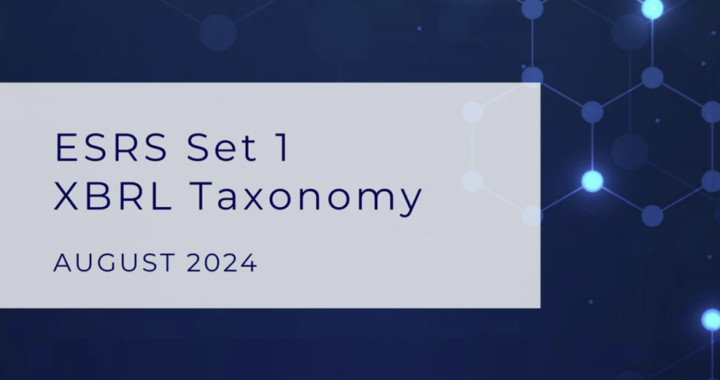Today (30/8) EFRAG released the ESRS XBRL Taxonomy, which enables the marking up (‘tagging’) of ESRS sustainability reports in machine-readable format. It contains more than 2000 datapoints whereof more than 400 Booleans (true/false, yes/no answers).
The taxonomy represents the digital transposition of the human-readable ESRS Set 1 published in July 2023.
It will be the basis for the European Securities and Market Authority (ESMA) to develop Regulatory Technical Standards for tagging the ESRS sustainability statement.
⭕ Prerequisite: reports should have a structure where it is reasonably easy to identify the datapoint in the section addressed in the report.
The granularity in the standards themselves was chosen so that the most granular paragraphs, subparagraphs and sub-subparagraphs in each DR always provide information that is decision-useful.
This granularity was therefore suitable to be used in the XBRL taxonomy to enable reports to convey information at a decision-useful level.
It is worth noting that the DR architecture has been embedded in the ESRS from the start (April 2022). EFRAG has been thinking in digital terms since the beginning.
⭕ Priority: Decision-usefulness
Information contained within sustainability reports prepared in accordance with the ESRS is likely to be useful to suppliers, clients, investors and other stakeholders of the undertaking that need to collect and aggregate information for their own sustainability reports or for other reporting requirements.
Determining the impact of the value chain, or of investments, on a specific granular datapoint (DP) is much more efficient if that same DP is digitally identified in reports coming from that value chain or investments.
👉 Patrick de Cambourg, the EFRAG SRB Chair, stated:
‘The final XBRL taxonomy marks a major milestone to enable machine-readable sustainability statements once adopted by ESMA and the EC.
The advanced approaches being implemented, especially for the tagging of narrative disclosures, will increase the usability of ESRS statements as users (analysts, investors, etc.) confirmed to EFRAG.
We encourage companies to use the ESRS taxonomy for their first ESRS statements on a voluntary basis; it is a useful tool to structure disclosures and will increase their decision-usefulness.
Let us not miss the opportunity to start with digital ESG disclosures from day one – because this is what users want.’
⭕Implementation of the narrative tagging hierarchy
The ESRS have been designed to systematically structure the ESRS sustainability statement into a list of detailed requirements corresponding to a given DR.
The core of a DR is in the main body of the standard and in a paragraph easily identifiable using the expressions ‘shall disclose’ and ‘shall include’ placed after the paragraph on the objective.
Usually, individual datapoints are identifiable by separate items reported in a list of letters: (a), (b), (c), etc. These can be further disaggregated in a sub-list of items identified by small roman numbers: (i), (ii), (iii), etc.
⭕The Disclosure Point (DP) structure is the following:
- the Level 1 XBRL element (known as parent) can be used to capture the full content of a Disclosure Requirement;
- the Level 2 XBRL element has dedicated elements (known as children) for each datapoint listed in the subparagraph of a DR (i.e., (a), (b), (c)); and,
- where applicable, additional XBRL elements have been implemented at the Level 3 in order to reflect the romaine numbered datapoints required by a specific DR (i.e., a(i), a(ii), a(iii)).
Additionally, Level 1 tags have an important meaning by providing a ‘content index’.
⭕Semi-narrative elements for usability and comparability of information
To improve the usability and comparability of information, EFRAG has created Semi-narrative elements, specifically Booleans and enumerations.
The Boolean corresponds to a ‘true’ or ‘false’ (yes/no) disclosure.
The enumeration is a predefined list (like a ‘drop-down menu’) created in the taxonomy that will facilitate the option to be selected from this list of items by choosing the most appropriate element (single choice) or more elements (multiple choices).
⭕The XBRL taxonomy for disclosure of IROs in ESRS 2, SBM-3
The XBRL taxonomy allows for the digital disaggregation of a single or grouped IROs (Impacts, Risks, Opportunities) and for the linking of Policies, Actions, and Targets to each of them.
A multiple-choice enumeration of sustainability matters (topics, subtopics and sub-subtopics) has been implemented, which allows for linking of the IRO to one or more sustainability matter.
⭕Providing context with relationships between topics, IROs, Policies, Actions and Targets
EFRAG has implemented relationships between topics, IROs, Policies, Actions and Targets in the taxonomy by linking IROs and topics, and by linking IROs and Policies, Actions & Targets (example: ‘Policy to choose suppliers that implement net zero target’ linked to target ‘All suppliers shall have a net zero target by 2035’).
A flexibility has been built in when a policy is not directly linked to a single IRO.
In order to provide a machine-readable link between IROs, policies, actions and targets, it is of particular relevance to use consistent identifiers or names across the report and across reporting periods.
⭕Incorporations by reference
The conditions for such incorporation, set in ESRS 1 paragraph 120, do not allow the incorporation of disclosures from any source or document outside of the Inline XBRL Document set (for example, from information provided on the webpage of the company or in a separate PDF).
Inline XBRL continuations provide flexibility in order to incorporate single disclosures by reference from different sections of the report, however those should not be used excessively and should be applied carefully in order not to lose the context of information provided.
Given the considerations above, if ESRS statements are completely digitally tagged, no specific disclosure for ESRS 2 BP-2 paragraph 16 has to be made. Therefore, no XBRL element has been implemented for this paragraph.
Source: https://www.efrag.org/en/news-and-calendar/news/efrag-publishes-the-esrs-set-1-xbrl-taxonomy
—
Stay tuned for more CSRD, ESRS and CSDDD insights.
✅ Adopt a streamlined, digital and taxonomy-centric ESRS report preparation with Cleerit ESG.
